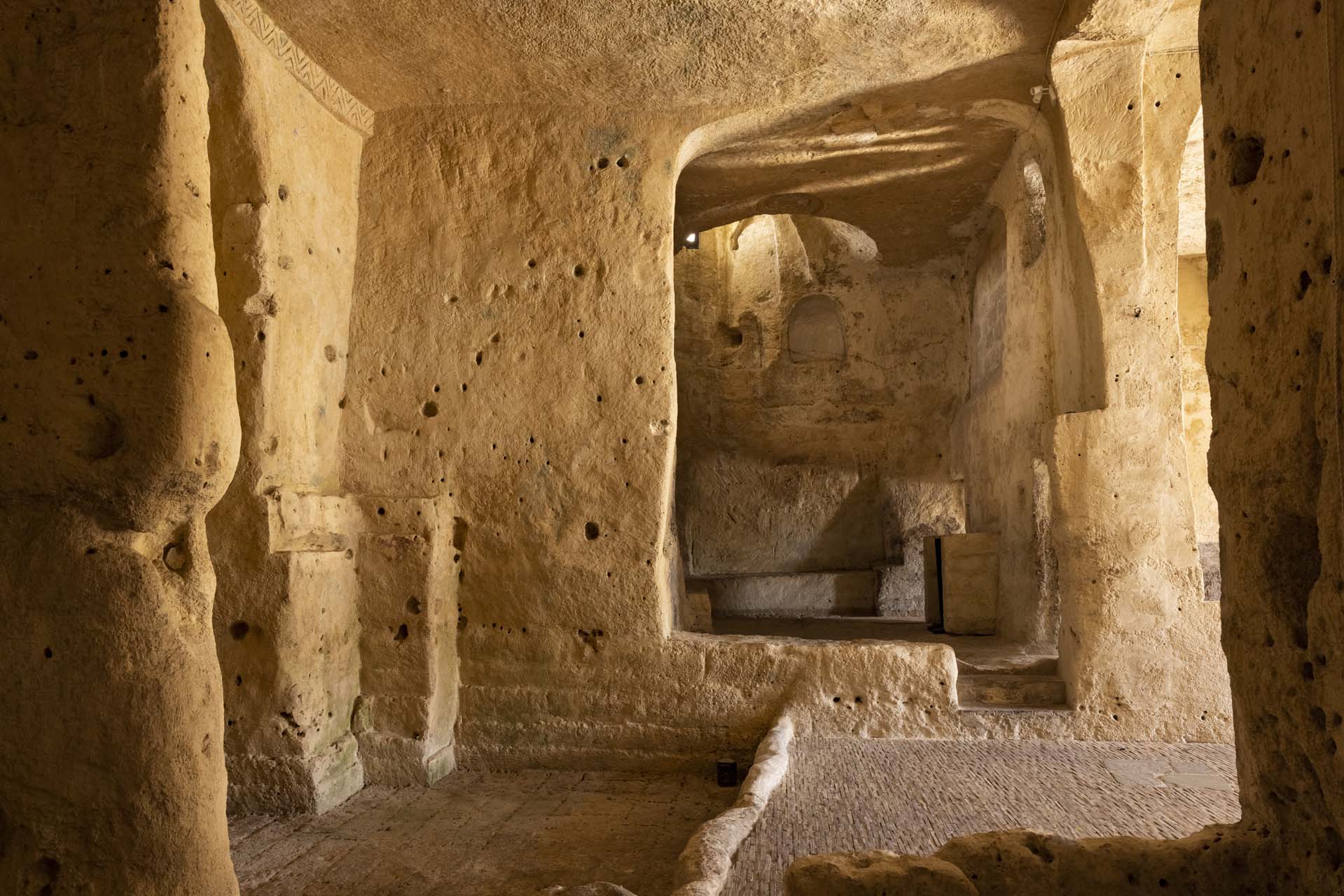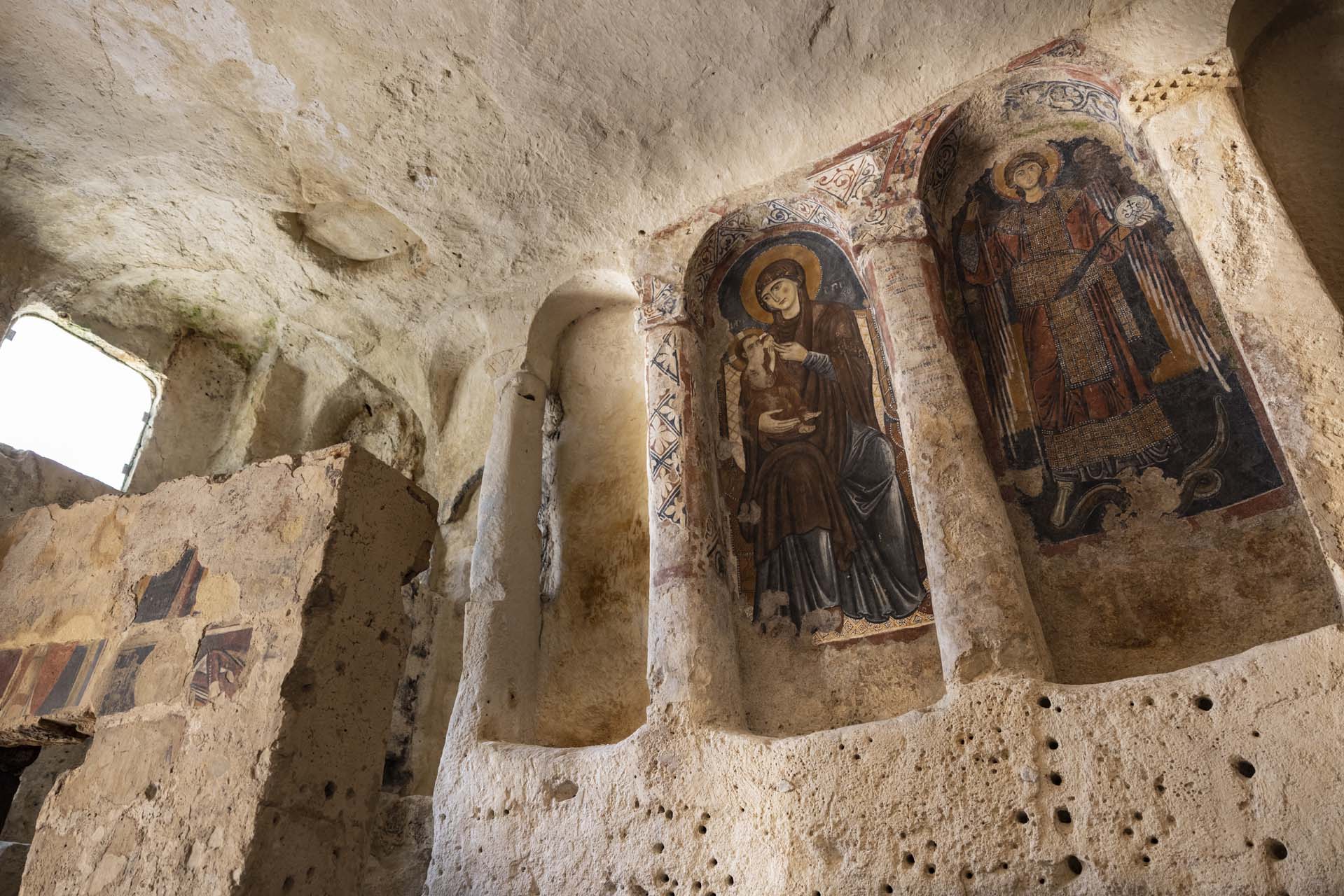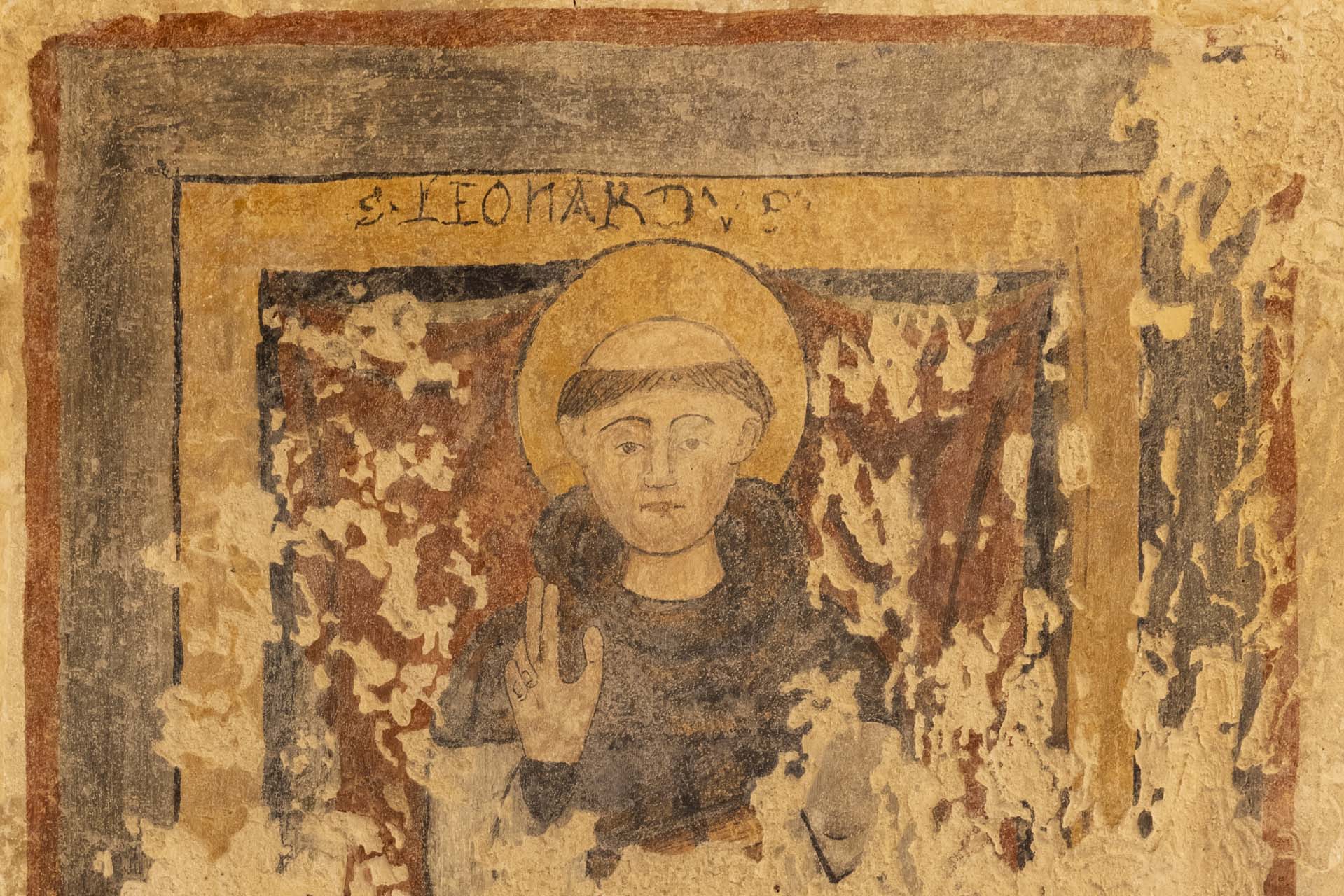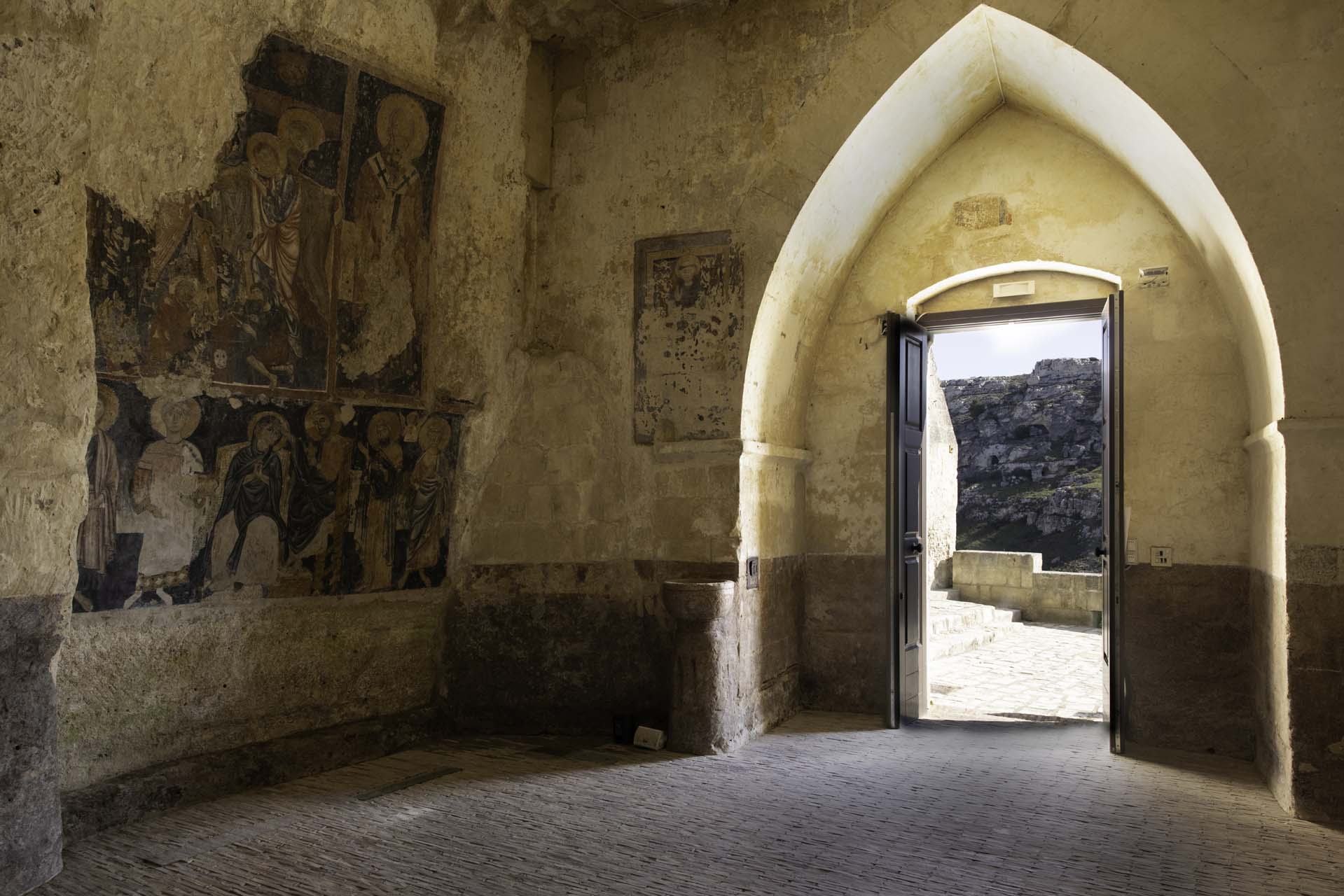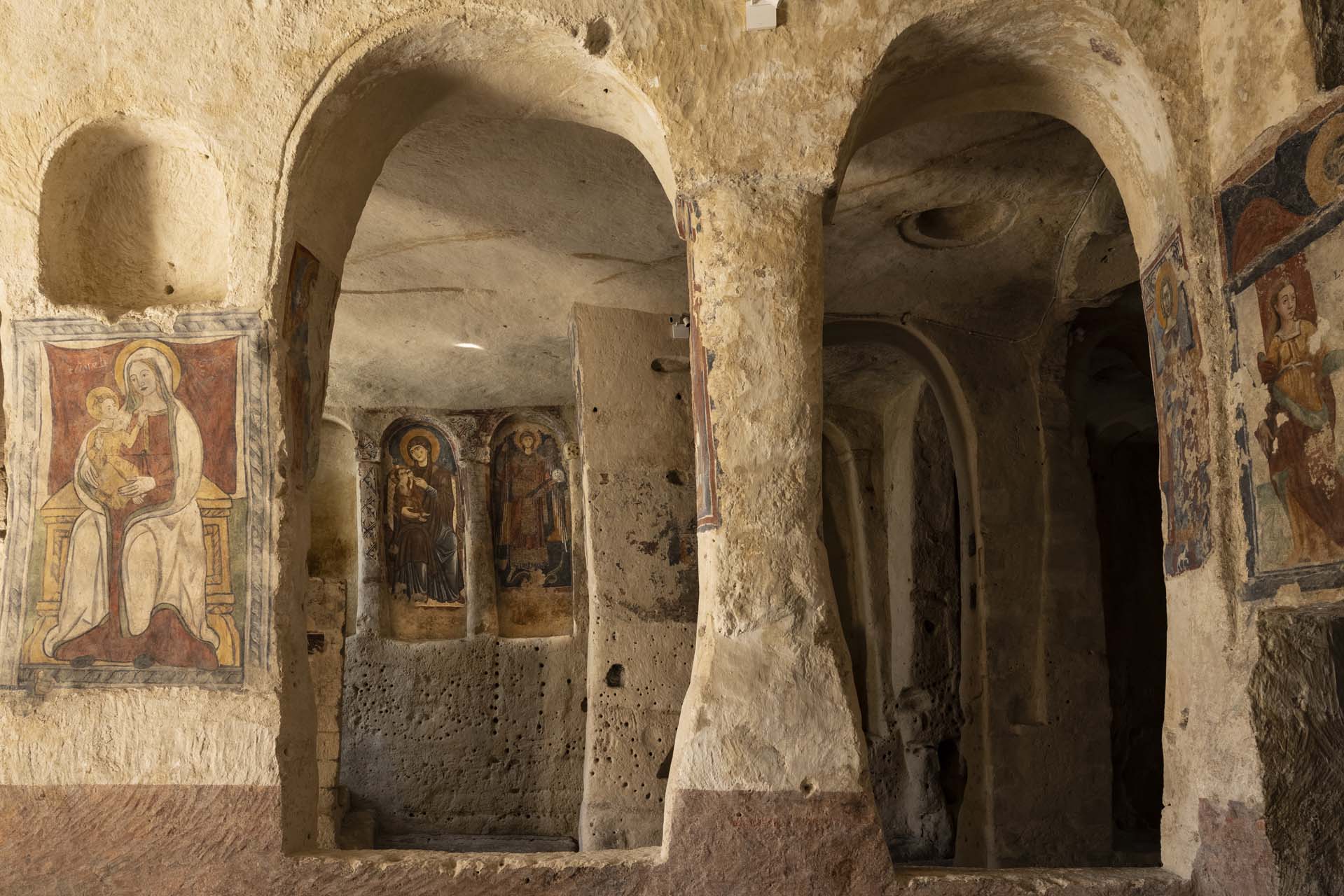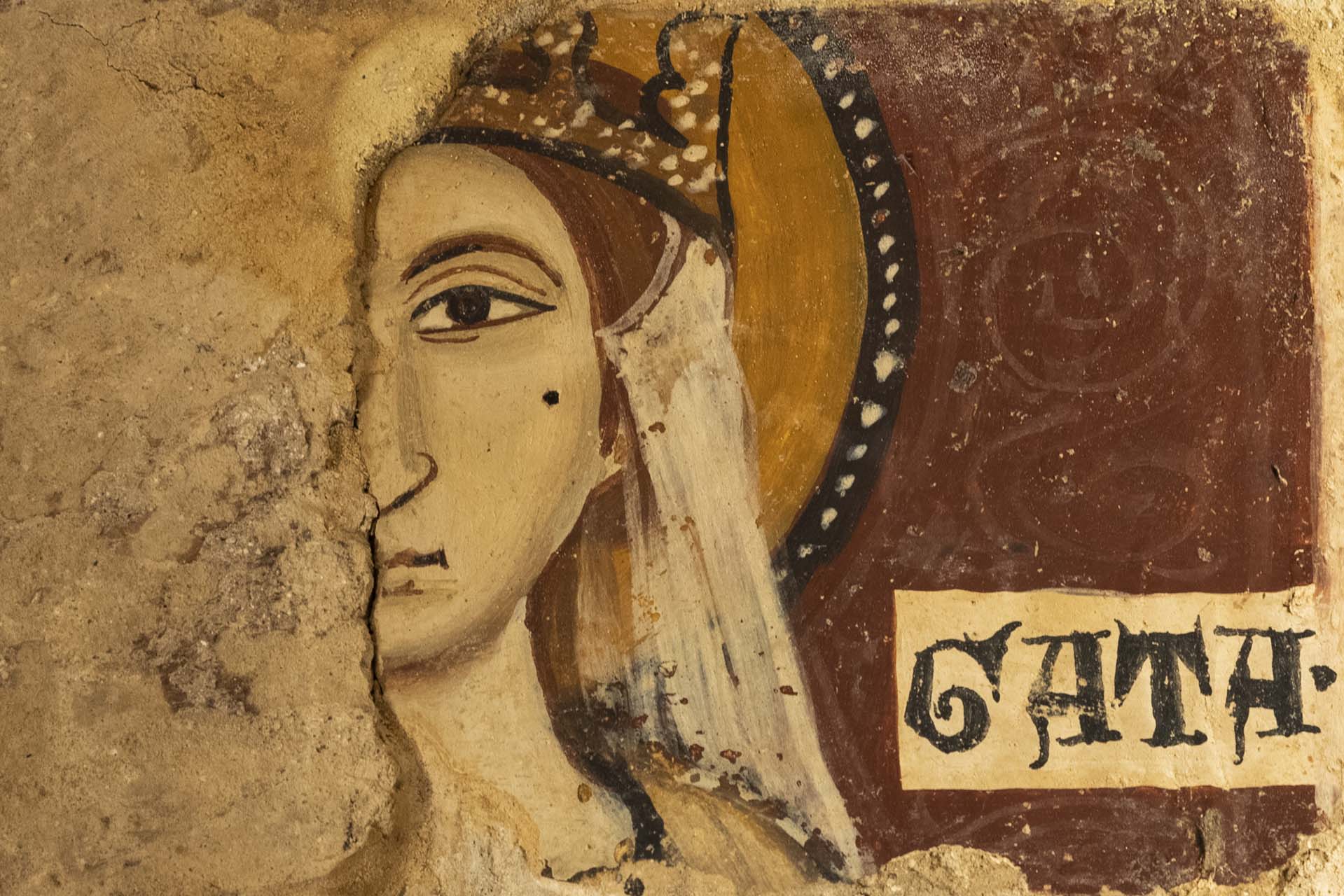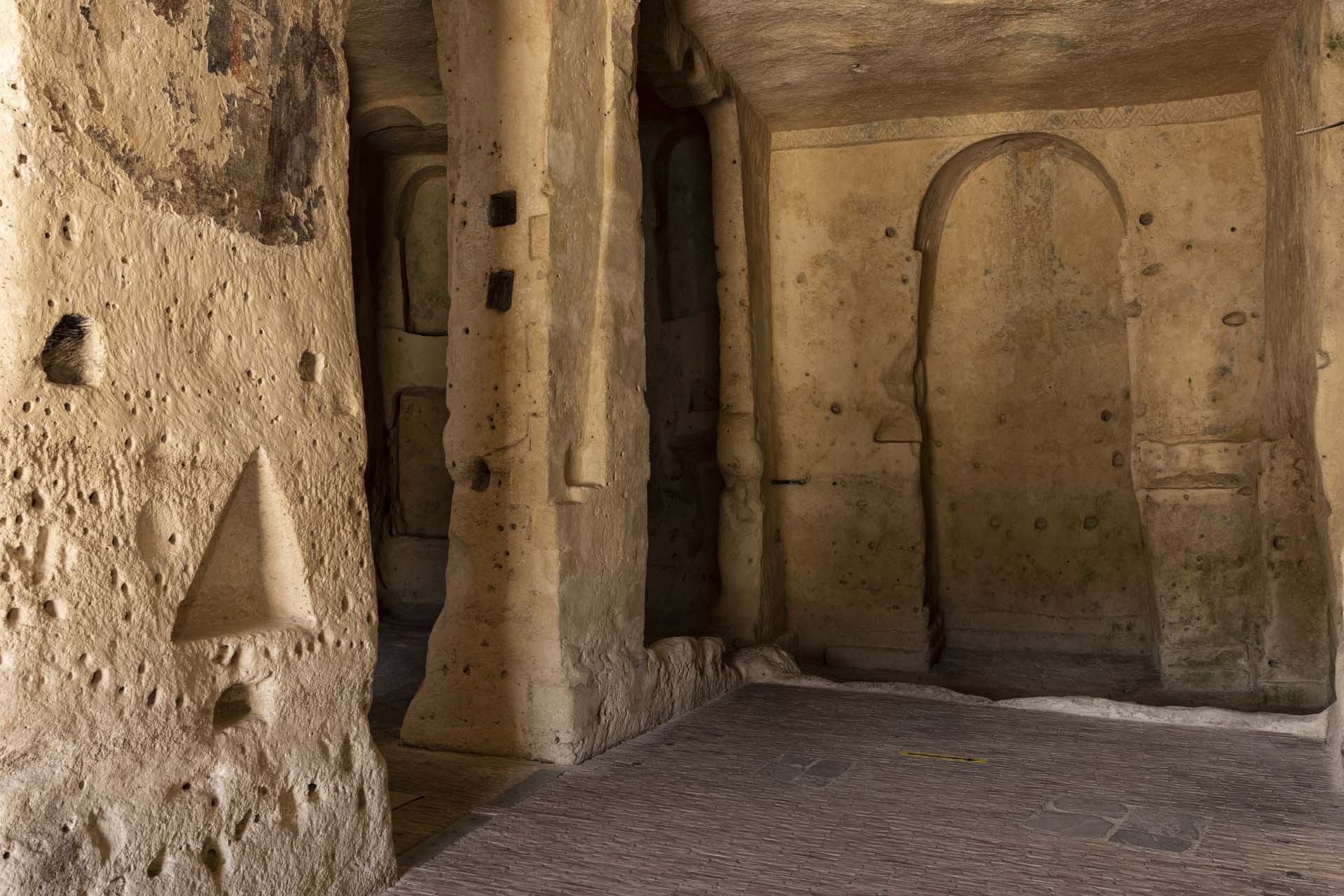Santa Lucia alle Malve
The rupestrian church of Santa Lucia alle Malve is the first female monastic settlement of the Benedictine Order, dating back to the VIII century, and the most important in the history of the city of Matera. A community that through its three successive monastic centers of Santa Lucia alle Malve, of Santa Lucia alla Civita and Santa Lucia al Piano has been an integral part of the life of Matera, following its historical-urban development over the course of a millennium. The external front of the former monastic complex develops along the rocky wall with a series of entrances that enter into as many internal cavities. The environments of the community are identified by its presence, high in relief in relief, from the symbolism of the martyrdom of Saint Lucia: the chalice with the two eyes of the Saint. The entrance to the church, on the right of the complex, is highlighted by squared tufa blocks that draw its line ending with an acute arch on whose bottom, within a lunette, is placed the liturgical symbol of the Saint.
Santa Lucia alle Malve is a church in rock of considerable size that develops in three distinct naves that despite having undergone heavy upheavals, after the abandonment by the monastic community, has left many of those signs to allow, with a hint of imagination , to reconstruct its planimetric and architectural development.
Of the three aisles that articulate the interior space, the right one, in which it is the current entrance, has always remained open to worship, so much so that even today on the day of Saint Lucia, December 13, there is a solemn mass here; the other two naves were transformed into dwellings and stores until the ’50s: a transformation that involved almost all the rock churches in the two districts of the Sassi, as they were replaced, liturgically, with buildings of worship erected in the new district of the Plan . These rock churches, deconsecrating, were transformed into homes, service rooms, stores, etc. with a process begun in the eighteenth century and continued until the early twentieth century
Originally, the central nave had to have the individual liturgical spaces with an upward movement from the level of the entrance door, up to the apse where the altar was located.
The presbytery, of all three naves, ie that part reserved only for priests, was enclosed by a series of columns, currently severed, that descended from the vault offering a touch of high suggestion enhanced by the mobility of the light emitted, at the time, from oil lamps.
The central nave was enriched with an iconostasis, that is, that architectural element belonging to the liturgical spaces of the Greek Orthodox cult, which constitutes a partition between the nave of the church (hall) and the presbytery, embellished by the thin columns descending from the vault and a base enriched by a series of frescoes that are currently found, sawn in squared blocks that make up a grotesque puzzle, in the structure of a flint that is located in the left aisle. A havoc occurred during the transformation of part of the church into a dwelling.
Remarkable, in the flat vault the lenticular cavities that enrich the prebiterial area: they are symbolic domes highlighted, in their size, by a series of concentric circles that give a sense of depth.
An introductory speech is necessary to explain the presence of ancient frescoes, some even of a millennium, so wonderfully preserved: they perfectly preserve their colors and their subjects only if executed with a precise technique, well known in the Materano territory by the many active frescant Mastri over the centuries.
This ancient artistic expression foresaw the laying of a layer of very wet plaster on which was placed a model in cardboard or other materials with the shape of the subject to represent finely pitted. It was then buffered with a piece soaked in coal dust leaving the trace on the light plaster. This explains the reason why in some cases, and often in the same church, there are two frescos perhaps with different colors but with the same shape, often even in positive and negative, as the same cardboard was used as a template model but maybe shot at the contrary.
Subsequently the fresco was definitively outlined and colored, using colors obtained by mixing lime, tufa powder, sometimes organic substances with vegetable pigments derived from flowers and plants and with colored powders derived from the shredding of particular minerals and earths. All this had to happen, however, until the support was still wet, drying in fact fixed the color in a practically indelible, as we can still observe.
Of great historical and artistic importance are the frescoes that still partly decorate the walls of the nave, which have returned, after the restoration, to the original splendor.
The Madonna del Latte dated around 1270 and executed by the same master painter who painted the Madonna della Bruna (in the Cathedral) named for this Master of Bruna, shows us the Madonna nursing the Child, in a gesture of tenderness that is probably represented to reaffirm a dimension closer to the man of that authoritarian and vindictive God as it was conceived in the Middle Ages. In order not to touch blasphemy, the fresco painter has depicted the Madonna’s breast in a decentralized way compared to real anatomy and small dimensions.
In the niche next to it, St. Michael the Archangel, dated 1250, in his role as messenger of God, covers a vestigraple studded with precious stones, symbol of the ambassadors of the imperial court of Byzantium and holds a seal with an inscribed Greek cross in one hand. In the other hand he has the labar and under his feet twists the dragon representing the devil. A Latin Christian iconography with harmoniously fused Oriental Christian elements.
On the large pillar that separates the left aisle from the central one, the fresco of a saint with the miter in his head and in his left hand the pastoral symbols of the episcopal authority, dated around the second half of the thirteenth century according to some scholars San Gregorio , for others San Donato, also by the Master of Bruna.
Above, the ascetic face of an unknown saint, dating back to the first half of the twelfth century, peeps out. A Saint mutilus, surviving the reduction of the square column carried out for the execution of the underlying San Gregorio. A destruction from which only the head was saved, probably by a devotional act of the fresco.
In the intrados of the arch, to the left of the current entrance, San Benedetto faces (just to witness the Benedictine origin of the complex), and Santa Scolastica, both founders of the great monastic orders that flourished in that period, while next to San blessed there is St. John the Baptist, the forerunner of Christ, covered with the typical camel leather with a scroll in his hand with a passage from the Gospel of John. All three frescoes are dated late thirteenth century.
The wall of the right aisle is embellished by a large panel depicting the Coronation of the Virgin, in which the Christ symbolically places a crown on the head of the Virgin to represent a moment in which the importance of the Marian cult increased after 1200.
On the sides in this panel, on the right San Giovanni Battista and San Pietro, on the left San Lorenzo and Santo Stefano.In the upper part, on the right, the Deposition of the fourteenth century Christ in which we note Giuseppe D’Arimatea which supports the body; On the scale, Nicodemus detaches his left arm from the cross and the Virgin approaches his right arm to his lips.
On the left, St. Nicholas, bishop of Mira, in the classic iconography handed down over the centuries.
They are frescoes dating back to the Angevin period around the fourteenth century, a particular pictorial style developed in the XIII-XIV century in Italy during the historical events that had as protagonists the members of the French family of the Angio.
To the side, Saint Lucia, patron of sight, dated 1610. Here is a St. Vitus with a dog placed at his feet, martyred under the emperor Diocletian, considered patron against the chorea, a disease of the nervous system, commonly known as St. Vito, a disease that manifests itself with sudden contractions and bizarre involuntary movements of the muscles of every part of the body. In an era in which medicine did not find healing remedies, we relied on healing for the benevolence of San Vito. On the left a seventeenth-century Madonna with Child.


